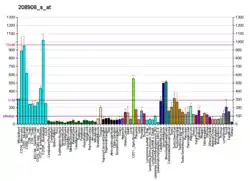Calpastatin
Calpastatin is a protein that in humans is encoded by the CAST gene.[5][6][7][8]
The protein encoded by this gene is an endogenous calpain (calcium-dependent cysteine protease) inhibitor. It consists of an N-terminal domain L and four repetitive calpain-inhibition domains (domains 1–4), and it is involved in the proteolysis of amyloid precursor protein. The calpain/calpastatin system is involved in numerous membrane fusion events, such as neural vesicle exocytosis and platelet and red-cell aggregation. The encoded protein is also thought to affect the expression levels of genes encoding structural or regulatory proteins. Several alternatively spliced transcript variants of this gene have been described, but the full-length natures of only some have been determined.[8]
References
- GRCh38: Ensembl release 89: ENSG00000153113 - Ensembl, May 2017
- GRCm38: Ensembl release 89: ENSMUSG00000021585 - Ensembl, May 2017
- "Human PubMed Reference:". National Center for Biotechnology Information, U.S. National Library of Medicine.
- "Mouse PubMed Reference:". National Center for Biotechnology Information, U.S. National Library of Medicine.
- Ma H, Yang HQ, Takano E, Lee WJ, Hatanaka M, Maki M (Sep 1993). "Requirement of different subdomains of calpastatin for calpain inhibition and for binding to calmodulin-like domains". J Biochem. 113 (5): 591–9. doi:10.1093/oxfordjournals.jbchem.a124088. PMID 8340353.
- Averna M, De Tullio R, Capini P, Salamino F, Pontremoli S, Melloni E (Dec 2003). "Changes in calpastatin localization and expression during calpain activation: a new mechanism for the regulation of intracellular Ca(2+)-dependent proteolysis". Cell Mol Life Sci. 60 (12): 2669–78. doi:10.1007/s00018-003-3288-0. PMID 14685690. S2CID 23794801.
- Raynaud P, Jayat-Vignoles C, Laforet MP, Leveziel H, Amarger V (Apr 2005). "Four promoters direct expression of the calpastatin gene". Arch Biochem Biophys. 437 (1): 69–77. doi:10.1016/j.abb.2005.02.026. PMID 15820218.
- "Entrez Gene: CAST calpastatin".
Further reading
- Murachi T (1989). "Intracellular regulatory system involving calpain and calpastatin". Biochem. Int. 18 (2): 263–94. PMID 2548504.
- Lee WJ, Ma H, Takano E, et al. (1992). "Molecular diversity in amino-terminal domains of human calpastatin by exon skipping". J. Biol. Chem. 267 (12): 8437–42. PMID 1569094.
- Adachi Y, Ishida-Takahashi A, Takahashi C, et al. (1991). "Phosphorylation and subcellular distribution of calpastatin in human hematopoietic system cells". J. Biol. Chem. 266 (6): 3968–72. PMID 1995645.
- Inazawa J, Nakagawa H, Misawa S, et al. (1991). "Assignment of the human calpastatin gene (CAST) to chromosome 5 at region q14----q22". Cytogenet. Cell Genet. 54 (3–4): 156–8. doi:10.1159/000132982. PMID 2265559.
- Uemori T, Shimojo T, Asada K, et al. (1990). "Characterization of a functional domain of human calpastatin". Biochem. Biophys. Res. Commun. 166 (3): 1485–93. doi:10.1016/0006-291X(90)91035-Q. PMID 2407243.
- Maki M, Bagci H, Hamaguchi K, et al. (1989). "Inhibition of calpain by a synthetic oligopeptide corresponding to an exon of the human calpastatin gene". J. Biol. Chem. 264 (32): 18866–9. PMID 2553724.
- Murachi T, Takano E, Maki M, et al. (1990). "Cloning and expression of the genes for calpains and calpastatins". Biochem. Soc. Symp. 55: 29–44. PMID 2559735.
- Asada K, Ishino Y, Shimada M, et al. (1991). "cDNA cloning of human calpastatin: sequence homology among human, pig, and rabbit calpastatins". J. Enzym. Inhib. 3 (1): 49–56. doi:10.3109/14756368909030363. PMID 2577276.
- Pontremoli S, Salamino F, Sparatore B, et al. (1989). "Characterization of the calpastatin defect in erythrocytes from patients with essential hypertension". Biochem. Biophys. Res. Commun. 157 (3): 867–74. doi:10.1016/S0006-291X(88)80955-0. PMID 2849943.
- Mimori T, Suganuma K, Tanami Y, et al. (1995). "Autoantibodies to calpastatin (an endogenous inhibitor for calcium-dependent neutral protease, calpain) in systemic rheumatic diseases". Proc. Natl. Acad. Sci. U.S.A. 92 (16): 7267–71. doi:10.1073/pnas.92.16.7267. PMC 41320. PMID 7638179.
- Després N, Talbot G, Plouffe B, et al. (1995). "Detection and expression of a cDNA clone that encodes a polypeptide containing two inhibitory domains of human calpastatin and its recognition by rheumatoid arthritis sera". J. Clin. Invest. 95 (4): 1891–6. doi:10.1172/JCI117870. PMC 295733. PMID 7706496.
- Wei SG, Wang LF, Miao SY, et al. (1995). "Expression of the calpastatin gene segment during spermiogenesis in human testis: an in situ hybridization study". Arch. Androl. 34 (1): 9–12. doi:10.3109/01485019508987826. PMID 7710300.
- Wang LF, Wei SG, Miao SY, et al. (1994). "Calpastatin gene in human testis". Biochem. Mol. Biol. Int. 33 (2): 245–51. PMID 7951045.
- Schwarz-Benmeir N, Glaser T, Barnoy S, Kosower NS (1995). "Calpastatin in erythrocytes of young and old individuals". Biochem. J. 304 (2): 365–70. doi:10.1042/bj3040365. PMC 1137502. PMID 7998969.
- Fujitani K, Kambayashi J, Sakon M, et al. (1997). "Identification of mu-, m-calpains and calpastatin and capture of mu-calpain activation in endothelial cells". J. Cell. Biochem. 66 (2): 197–209. doi:10.1002/(SICI)1097-4644(19970801)66:2<197::AID-JCB7>3.0.CO;2-L. PMID 9213221.
- Wang KK, Posmantur R, Nadimpalli R, et al. (1998). "Caspase-mediated fragmentation of calpain inhibitor protein calpastatin during apoptosis". Arch. Biochem. Biophys. 356 (2): 187–96. doi:10.1006/abbi.1998.0748. PMID 9705209. S2CID 11593624.
- Han Y, Weinman S, Boldogh I, et al. (1999). "Tumor necrosis factor-alpha-inducible IkappaBalpha proteolysis mediated by cytosolic m-calpain. A mechanism parallel to the ubiquitin-proteasome pathway for nuclear factor-kappab activation". J. Biol. Chem. 274 (2): 787–94. doi:10.1074/jbc.274.2.787. PMID 9873017.
- Ishikawa H, Nakagawa Y, Shimizu K, et al. (2000). "Inflammatory cytokines induced down-regulation of m-calpain mRNA expression in fibroblastic synoviocytes from patients with osteoarthritis and rheumatoid arthritis". Biochem. Biophys. Res. Commun. 266 (2): 341–6. doi:10.1006/bbrc.1999.1819. hdl:2433/180881. PMID 10600505.






